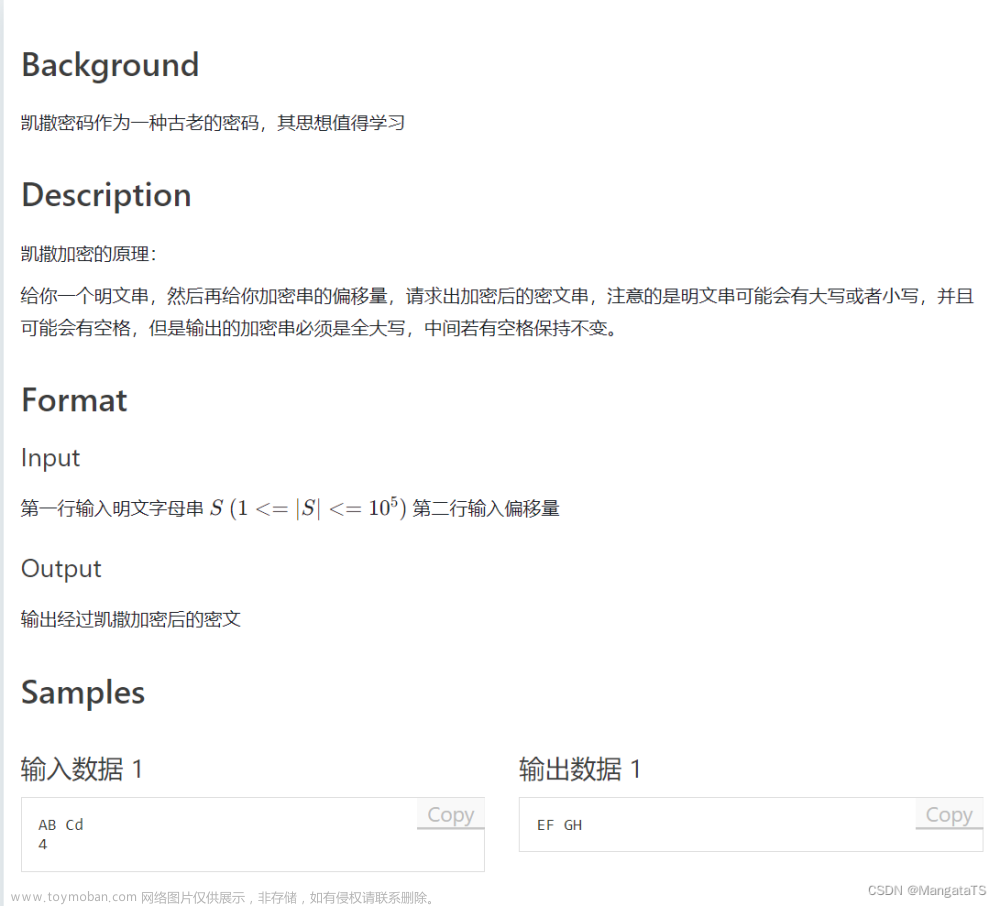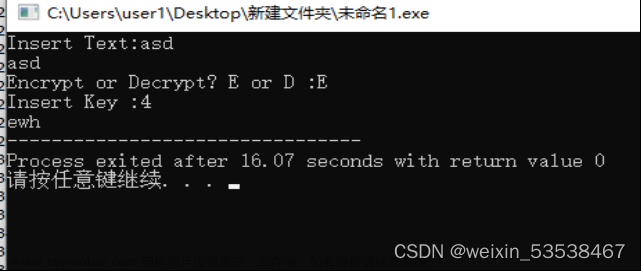凯撒密码(Caesar Cipher)是一种简单的替代加密技术,以罗马大帝凯撒·尤利乌斯·凯撒(Julius Caesar)的名字命名。它通过将每个字母按照字母表向后移动固定数量的位置来进行加密。
示例一:
/**
* @file caesar_cipher.cpp
* @brief Implementation of [Caesar cipher](https://en.wikipedia.org/wiki/Caesar_cipher) algorithm.
*
* @details
* In cryptography, a Caesar cipher, also known as Caesar's cipher, the shift cipher,
* Caesar's code or Caesar shift, is one of the simplest and most widely known encryption
* techniques. It is a type of substitution cipher in which each letter in the plaintext
* is replaced by a letter some fixed number of positions down the alphabet. For example,
* with a left shift of 3, D would be replaced by A, E would become B, and so on.
* The method is named after Julius Caesar, who used it in his private correspondence.
*
* ### Algorithm
* The encryption can also be represented using modular arithmetic by first transforming
* the letters into numbers, according to the scheme, A → 0, B → 1, ..., Z → 25.
* Encryption of a letter x by a shift n can be described mathematically as,
* \f[ E(x) = (x + n)\;\mbox{mod}\; 26\f]
* while decryption can be described as,
* \f[ D(x) = (x - n) \;\mbox{mod}\; 26\f]
*
* \note This program implements caesar cipher for only uppercase English alphabet characters (i.e. A-Z).
*
* @author [Deep Raval](https://github.com/imdeep2905)
*/
#include <iostream>
#include <string>
#include <cassert>
/** \namespace ciphers
* \brief Algorithms for encryption and decryption
*/
namespace ciphers {
/** \namespace caesar
* \brief Functions for [Caesar cipher](https://en.wikipedia.org/wiki/Caesar_cipher) algorithm.
*/
namespace caesar {
namespace {
/**
* This function finds character for given value (i.e.A-Z)
* @param x value for which we want character
* @returns corresponding character for perticular value
*/
inline char get_char(const int x) {
// By adding 65 we are scaling 0-25 to 65-90.
// Which are in fact ASCII values of A-Z.
return char(x + 65);
}
/**
* This function finds value for given character (i.e.0-25)
* @param c character for which we want value
* @returns returns corresponding value for perticular character
*/
inline int get_value(const char c) {
// A-Z have ASCII values in range 65-90.
// Hence subtracting 65 will scale them to 0-25.
return int(c - 65);
}
} // Unnamed namespace
/**
* Encrypt given text using caesar cipher.
* @param text text to be encrypted
* @param shift number of shifts to be applied
* @returns new encrypted text
*/
std::string encrypt (const std::string &text, const int &shift) {
std::string encrypted_text = ""; // Empty string to store encrypted text
for (char c : text) { // Going through each character
int place_value = get_value(c); // Getting value of character (i.e. 0-25)
place_value = (place_value + shift) % 26; // Applying encryption formula
char new_char = get_char(place_value); // Getting new character from new value (i.e. A-Z)
encrypted_text += new_char; // Appending encrypted character
}
return encrypted_text; // Returning encrypted text
}
/**
* Decrypt given text using caesar cipher.
* @param text text to be decrypted
* @param shift number of shifts to be applied
* @returns new decrypted text
*/
std::string decrypt (const std::string &text, const int &shift) {
std::string decrypted_text = ""; // Empty string to store decrypted text
for (char c : text) { // Going through each character
int place_value = get_value(c); // Getting value of character (i.e. 0-25)
place_value = (place_value - shift) % 26;// Applying decryption formula
if(place_value < 0) { // Handling case where remainder is negative
place_value = place_value + 26;
}
char new_char = get_char(place_value); // Getting original character from decrypted value (i.e. A-Z)
decrypted_text += new_char; // Appending decrypted character
}
return decrypted_text; // Returning decrypted text
}
} // namespace caesar
} // namespace ciphers
/**
* Function to test above algorithm
*/
void test() {
// Test 1
std::string text1 = "ALANTURING";
std::string encrypted1 = ciphers::caesar::encrypt(text1, 17);
std::string decrypted1 = ciphers::caesar::decrypt(encrypted1, 17);
assert(text1 == decrypted1);
std::cout << "Original text : " << text1;
std::cout << " , Encrypted text (with shift = 21) : " << encrypted1;
std::cout << " , Decrypted text : "<< decrypted1 << std::endl;
// Test 2
std::string text2 = "HELLOWORLD";
std::string encrypted2 = ciphers::caesar::encrypt(text2, 1729);
std::string decrypted2 = ciphers::caesar::decrypt(encrypted2, 1729);
assert(text2 == decrypted2);
std::cout << "Original text : " << text2;
std::cout << " , Encrypted text (with shift = 1729) : " << encrypted2;
std::cout << " , Decrypted text : "<< decrypted2 << std::endl;
}
/** Driver Code */
int main() {
// Testing
test();
return 0;
}
示例二:
使用C++实现凯撒密码的示例:
#include <iostream>
#include <string>
using namespace std;
// 凯撒密码加密函数
string encryptCaesarCipher(string plaintext, int shift) {
string ciphertext = "";
for (int i = 0; i < plaintext.length(); i++) {
if (isalpha(plaintext[i])) {
// 获取字符的ASCII码
int ascii = int(plaintext[i]);
// 根据移动位数进行替代
if (islower(plaintext[i])) {
ascii = (ascii - 97 + shift) % 26 + 97;
} else {
ascii = (ascii - 65 + shift) % 26 + 65;
}
// 将替代后的字符添加到密文中
ciphertext += char(ascii);
} else {
// 非字母字符直接添加到密文中
ciphertext += plaintext[i];
}
}
return ciphertext;
}
// 凯撒密码解密函数
string decryptCaesarCipher(string ciphertext, int shift) {
string plaintext = "";
// 将移位数转换为负数,以实现向前移动的效果
shift = -shift;
// 调用加密函数进行解密
plaintext = encryptCaesarCipher(ciphertext, shift);
return plaintext;
}
int main() {
string plaintext = "Hello, World!";
int shift = 3;
// 加密并输出密文
string ciphertext = encryptCaesarCipher(plaintext, shift);
cout << "Ciphertext: " << ciphertext << endl;
// 解密并输出明文
string decryptedText = decryptCaesarCipher(ciphertext, shift);
cout << "Decrypted Text: " << decryptedText << endl;
return 0;
}
在上述示例代码中,`encryptCaesarCipher`函数实现了凯撒密码的加密过程,`decryptCaesarCipher`函数实现了凯撒密码的解密过程。使用`main`函数来测试加密和解密功能,并输出结果。文章来源:https://www.toymoban.com/news/detail-781898.html
注意,该凯撒密码实现只对字母字符进行加密和解密,非字母字符将保持原样。同时,移位数应为正整数,表示向后移动的位数。解密过程是通过将移位数转换为负数,然后调用加密函数实现的。文章来源地址https://www.toymoban.com/news/detail-781898.html
到了这里,关于c++ 凯撒密码的文章就介绍完了。如果您还想了解更多内容,请在右上角搜索TOY模板网以前的文章或继续浏览下面的相关文章,希望大家以后多多支持TOY模板网!










